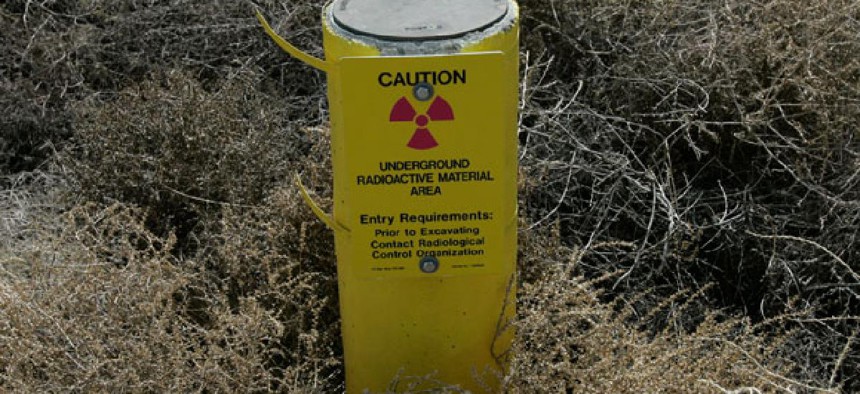Watchdog Groups Blast White House-Backed Nuclear Cleanup Study

Ted S. Warren/AP file photo
Feds agree to extend the comment period.
Following scathing criticism from watchdog organizations, officials preparing a controversial report on nuclear incident cleanup reportedly backed by the White House have opted to extend public comment on the document by nearly two weeks.
Commissioned by the Homeland Security Department, the draft report suggests remediation guidelines in which up to roughly one in 20 people would be expected to develop cancer from long-term radiation exposure. The deadline for the public to comment on the draft report was to expire April 4, but its authors have opted to push the date back to April 15.
Under guidelines established by the Environmental Protection Agency’s Superfund program in the 1980s, cleanup of toxic sites in the United States are usually designed so that, in a worst-case scenario, no more than one in 10,000 people would be expected to develop cancer due to extended exposure to contaminants. The new report, organized by the private National Council of Radiation Protection and primarily drafted by federal officials, suggests such standards are not practical following a massive disaster such as the 2011 Fukushima nuclear plant meltdown in Japan, along with considerably smaller dirty bomb attacks.
Activists throughout the country argue the report’s argument is misplaced.
“NCRP’s response to lessons learned is simply to redefine ‘clean’ by lowering the cleanup standard [and] is frankly criminal,” Mary Lampert, director of the Massachusetts-based Pilgrim Watch said in comments submitted on Thursday. “Just as ‘wrong’ does not become ‘right’ by rewriting the Commandments to ‘Though shall’ from ‘Thou shall not;’ dirty does not become clean; nor harmful become harmless by a stroke of the pen to change the definitions.”
Lampert said the “only humane and sane approach would be for NCRP to recommend measures to reduce the risk of nuclear disasters in light of the potentially real and potentially devastating economic and human consequences; and then to recommend policies and a framework to deal with short and long-term off-site consequences.”
She noted the federal government has yet to decide which of its agencies would be in charge of cleanup after a nuclear power plant incident and who would be responsible for paying for the work. She and other activists have also complained that the Nuclear Regulatory Commission has been slow to require certain mitigation measures, such as installing radiation filters on venting systems at Fukushima-style reactors.
Activists also complained that personnel from the EPA Superfund office were not included among the federal officials who drafted the report and that the authors also did not consult with public interest groups.
“The panel’s process has operated under the general public’s radar screen,” according to Lampert’s comments. “Had it not been for reporting by Global Security Newswire, [Pilgrim Watch] would not have been aware of the draft and the date set to submit comment.”
At least 17 other public interest groups have also expressed concern about the 587-page draft report during the last week, and had requested that the comment deadline be extended 60 days.
Writing on behalf of 16 of the organizations, Diane D’Arrigo, of the Maryland-based Nuclear Information and Resource Service, raised fears that the report “is clearly intended to serve as an influential recommendation that will affect the regulations that protect the public from ionizing radiation,” and requested more time to “fully review and provide input.” Daniel Hirsch, of the California-based Committee to Bridge the Gap, said activists are pushing for the issue to be a focus of Gina McCarthy’s Senate confirmation hearing to become the next EPA administrator.
The controversy surrounding the draft report comes as the Environmental Protection Agency is poised to release a new guidance document that is also widely expected to suggest that Superfund standards need not be applied to all nuclear incidents. The White House cleared the EPA guide for release last week.
In a statement to GSN, EPA spokeswoman Julia Valentine said the new guide will “reflect the best available radiation science” and “will not affect the agency’s Superfund authorities, existing cleanup regulations or current health and safety standards.”
Agency officials have made similar statements regarding prior drafts of the guide in recent years – including remarks that defended a Bush-era draft of the same guide suggesting people could drink water contaminated at levels thousands of times what the agency would normally allow. Those statements have done little to placate critics both in and outside the government who have raised concerns about the precedent such a federal document would establish and who have noted that recent studies by the National Academies of Science suggest radiation is even more dangerous than once thought.
While most draft versions of the guide have included disclaimers saying the document should not affect standards at existing Superfund sites, they have not ruled out the possibility that the conventional cleanup approach would not be used for remediation after a radiological “dirty bomb” attack, nuclear power plant accident or similar event. In addition, the draft NCRP report currently open for comment suggests using a loosely defined approach called “optimization” instead, and says the White House backs this suggestion.
Lampert argued in her comments on the draft report that that the National Academies of Science, rather than the NCRP organization, should lead study of the issue. The NCRP panel appears biased, Lampert contended, based on who was not included on it and on statements made in the unfinalized document.
As an example of the report’s alleged bias, Lampert argued it mischaracterizes the consequences of the 1979 Three Mile Island nuclear reactor meltdown in Pennsylvania. The draft report states the incident “did not result in any radiological injury or offsite contamination” but Lampert noted that the Nuclear Regulatory Commission estimated that 10 million curies of radiation were released during the incident while industry experts estimated between 17 million and 1 billion curies. Subsequent studies showed radiation-linked disease in the surrounding communities, Lampert claimed.
NEXT STORY: Demand grows for data scientists






